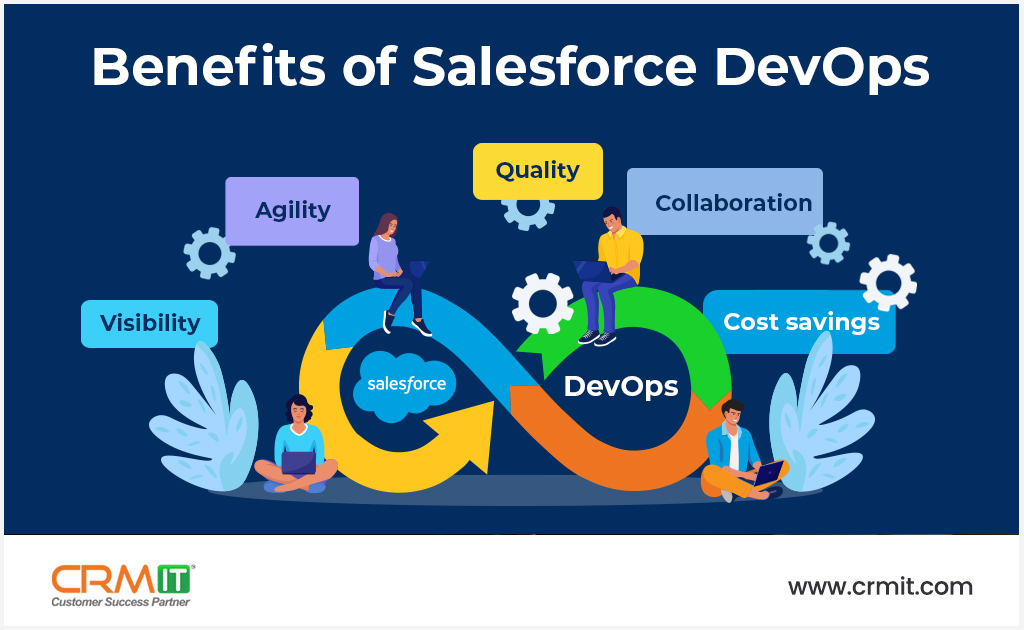Benefits of DevOps in Salesforce Development

DevOps is a software development methodology that focuses on collaboration and communication between development and operations teams to create a more efficient and streamlined development process. When combined with Salesforce, DevOps can bring a number of benefits to organizations looking to optimize their Salesforce deployment.
The first benefit of DevOps in Salesforce is increased agility. With DevOps, teams can quickly and easily make changes to their Salesforce instance without disrupting other processes or causing downtime. This means that updates and changes can be made on the fly, allowing teams to stay agile and responsive to changes in the market or business needs.
The second benefit is improved quality. By using DevOps in Salesforce practices like continuous integration and continuous delivery (CI/CD), teams can catch issues and bugs early in the development process. This leads to higher-quality code and fewer errors or issues down the line. This is especially important in Salesforce, where even small errors can have significant consequences.
The third benefit is better collaboration. DevOps practices encourage cross-functional teams to work together, breaking down silos and improving communication. This can lead to faster and more efficient development, as well as a better understanding of the business needs and priorities.
Another benefit of using DevOps with Salesforce is better visibility. By implementing automated testing and deployment processes, teams can gain real-time visibility into the status of their Salesforce instance. This means they can quickly identify and resolve any issues or errors, improving overall performance and stability.
Using DevOps in Salesforce can lead to cost savings. By automating repetitive tasks and streamlining processes, teams can save time and reduce the risk of errors. This can lead to cost savings in terms of developer time, infrastructure, and other resources.
DevOps is a powerful tool for optimizing Salesforce deployments. By improving agility, quality, collaboration, visibility, and cost savings, organizations can ensure that their Salesforce instance is running at its best, meeting the needs of the business and providing a competitive advantage.
Below are some of the DevOps tool options that Customer have:
- Salesforce DX: This is Salesforce’s own DevOps tool, specifically designed for building and deploying Salesforce applications. Salesforce DX provides features such as source-driven development, version control, and continuous integration.
- Copado: Copado is a native Salesforce DevOps solution that provides features such as version control, continuous integration, and continuous delivery. It also provides an integration with Salesforce DX and other DevOps tools.
- Gearset: Gearset is a cloud-based DevOps tool for Salesforce that provides features such as automated deployments, version control, and continuous integration. It also provides an easy-to-use interface and integrates with other DevOps tools.
- Blue Canvas: Blue Canvas is a DevOps solution for Salesforce that provides features such as version control, continuous integration, and automated deployments. It also provides a visual interface for managing and deploying changes.
- Jenkins: Jenkins is an open-source automation server that is widely used for continuous integration and continuous delivery. It can be used to build, test, and deploy Salesforce applications.
- GitLab: GitLab is a web-based Git repository manager that provides features such as continuous integration, continuous delivery, and version control. It also provides a Salesforce extension that allows users to deploy changes directly to Salesforce from GitLab.
In conclusion, there are many different DevOps tools available for Salesforce customers to choose from, each with its own set of features and benefits. By selecting the right tool for their needs, Salesforce customers can optimize their deployments and achieve greater agility, quality, and collaboration.
Saurabh N Gupta
Tags: DevOps, Salesforce

